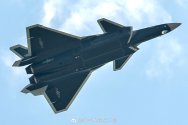3x longer detection range would mean an increase of ~13x the energy output. I don't think that is feasible wrt to cooling etc.
The point of GaN on SiC is greater heat absorption. The power itself is reachable because there’s much greater heat sinking at the module level.
It’s also not like you are running the radars on peak power constantly. Ultimately what matters is average rate at which your system adds heat vs average rate at which it transfers it. Much greater peaks don’t always mean much greater averages.
I don't think we should use the 3x range comment as gospel. Let's just take that as the new radar is likely significantly longer ranging than earlier j-20. Whether that's comparing J-20A/J-20S radar vs latest J-20 radar or an earlier J-20 GaA radar, I don't think it's too clear. Just use the article to appreciate that the range improved significantly.
Improved range would be achieved from not only higher RF output, but also better compute and software improvement. The latter does not require as much power as the former.
As for cooling, you get less heat for the same output from a higher voltage platform. Higher volt -> less flow for the same power
I keep mentioning higher voltage platform for a reason.
SiC substrate should also be a better heat conductor than Si as you can see in various available tables. Also improved tech meaning less power gets leaked & more of it goes out, again better power efficiency and less residual heat.
No, J-20 always had GaN-on-SiC radar not just J-20AS/A!
CETC had a visit from Xi either earlier last year or the year before (can't remember) that had him holding a SiC substrate for RF. At the time, it was said to be a major breakthrough.
GaN-on-SiC at production level is a recent phenomenon.
There are several GaN technologies. Not just GaN on SiC. There is GaN on Si, there is GaN on Sapphire, etc.
The main advantage of using SiC as a substrate is that it handles higher temperatures better while still being relatively cheap to manufacture.
They actually only got good at SiC substrate in the past year or so. It takes time for stuff to mature. Just because they could do 4-inch SiC substrate back 5 years ago for power applications, people should not assume 6-inch military grade RF SiC substrate was also available at that time.
Not always the case, Chinese military has more mature engines compared with its civilian counterparts. For all we know the military might have been the ones to drive down the production prices of GaN so that it became competitive in the civilian market.
I don't have any proof, but I don't think China would have started production of J-20 without the latest and capable technology they can get their hands on.
the military demand for GaN is quite small vs civilian side of things.
Just to put things in perspective, Guobo (who makes MMIC for military aircraft) built a production line for 20 million GaN RF chips for 5G base stations per year. What do you think is the scale for military aircraft compared to that?
And it seems like they put J-20 in service as soon as they can in order to start tactical development of employing & countering stealth aircraft. I don't see why they can't put it in service with GaA radar.
Oh my God I cannot get over how good the electric (?) blue tint looks on those EO windows.
It really does look great. Also another huge power consumer. I'd be curious what kind of improvement in range they got from this new EOTS.


